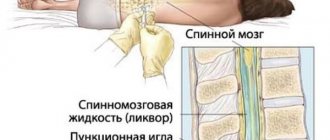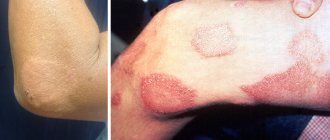Peritonitis is a dangerous disease that has claimed the lives of millions of people. The danger lies in the rapid development of symptoms of abdominal peritonitis, which suddenly appear against the background of complete well-being.
Symptoms of abdominal peritonitis in adults depend on the causes of the disease, as well as the stage of peritonitis.
- Pain syndrome. Peritonitis is characterized by a sudden onset with the appearance of pain in the abdominal area. Signs of peritonitis are localized at the site of the primary source of inflammation. Subsequently, pain symptoms are diffuse. Increased pain occurs when changing body position, accompanied by tension in the anterior abdominal wall. The severity and nature of the pain depends on the cause of the disease. The destruction of the pancreas is considered the most painful, as enzymes enter the peritoneum. Such an aggressive environment of pancreatic juice resembles hydrochloric acid that has come into contact with unprotected skin;
- Nausea and vomiting. The pain and vomiting centers are located quite close to each other in the medulla oblongata, this explains such signs of peritonitis in women and men;
- Board-shaped belly. An external examination reveals tension in the muscles of the anterior abdominal wall, which is a sign of irritation.
- Increased body temperature. Hyperthermia refers to intoxication syndrome. As a rule, the temperature rises to thirty-nine degrees, which makes the infectious agent pathogenic;
- Tachycardia. Peritonitis has a nonspecific symptom in the form of increased heart rate. This reflects the severity of intoxication;
- Fall in blood pressure. This sign is a poor prognostic criterion for the patient. The terminal stage of the pathology is expressed in low blood pressure numbers, since the body’s compensatory reactions cannot cope with the inflammatory process;
- Feeling thirsty. Drinking plenty of water does not bring relief. In the early stages, upon examination, the tongue will be covered with a copious dry white coating; later, the coating acquires a brown tint;
- Dry skin. With peritonitis, such symptoms in adults are observed with dehydration. The patient's facial features become sharper, and the mucous membranes stand out clearly;
- Convulsive syndrome. It is observed when the water-electrolyte balance increases. Such twitching is most often localized on the lower extremities. As the disease progresses, seizures tend to spread upward;
- Oliguria. Inflammation of the peritoneum has symptoms indicating a decrease in the daily volume of urination. As a result, toxins that are normally eliminated from the body through urine are retained in the patient;
- Imaginary well-being. Signs of abdominal peritonitis in both women and men subside after severe clinical symptoms. Such a bright period is a dangerous condition, since during this period many patients may refuse the necessary hospitalization. The condition can last about three hours, and then the pain syndrome returns with renewed vigor;
- Violation of peristalsis. It is characterized in both adults and children by a slowdown or complete cessation of peristaltic waves. In this case, peristalsis cannot be heard even with a phonendoscope;
- Peritoneal irritation. Symptoms are determined by individual human characteristics. With an increased pain threshold, patients are less sensitive to pain symptoms and tolerate this condition more easily. This behavior entails late seeking of medical help, which affects the outcome of the disease;
- Confusion. Against the background of severe pain and intoxication syndrome, a cascade of biochemical reactions occurs, which causes a disturbance of consciousness. The patient is not oriented in time and space. However, this only happens as the pathology progresses.
Classic symptoms of acute abdomen are observed with diffuse peritonitis.
Signs of peritonitis are important diagnostic criteria when making a diagnosis.
At the Yusupov Hospital, patients with peritonitis undergo thorough diagnostics using modern technical capabilities. Effective treatment and rehabilitation measures are carried out by competent specialists of the highest category. The Yusupov Hospital is a unique institution that has united the best specialists in Russia under its roof.
Causes of peritonitis
In most cases, the cause of peritonitis is infection. It can move from other organs or be brought in from the outside: after prolonged use of catheters (during dialysis), during unskilled surgical intervention or as a result of trauma or injury. The infection can also be in the blood and enter the abdominal cavity.
The contents of the organs can include not only infectious agents, but also substances that, when released into the peritoneum, destroy its tissue and promote inflammation, for example, enzymes and bile.
Inflammation can develop against the background of existing diseases (Fig. 1):
- appendicitis (when the appendix ruptures),
- cholecystitis (inflammation of the gallbladder),
- ulcers of the stomach or duodenum (if the ulcer is perforated),
- acute intestinal obstruction,
- Crohn's disease (autoimmune inflammatory disease of the gastrointestinal tract),
- pancreatitis (inflammation of the pancreas),
- diverticulitis (protrusion of the walls) of the digestive organs,
- liver cirrhosis,
- inflammatory diseases of the pelvic organs, etc.
Figure 1. Some common causes of peritonitis in women.
Source: Townsend: Sabiston Textbook of Surgery, 17th ed./Elsevier A variety of bacteria can cause peritonitis, for example:
- chlamydia (the causative agent of chlamydia),
- gonococci (the causative agent of gonorrhea),
- Treponema pallidum (the causative agent of syphilis),
- Mycobacterium tuberculosis,
- staphylococci,
- coli.
Important! If a person has previously had peritonitis, it is more likely to occur again than in people without a history of peritonitis.
Post-op period
The recovery stage (after surgery) includes the following activities:
- Infusion of solutions capable of restoring the acid-base, water, electrolyte balance in the patient’s body.
- Restoring the functions of the liver, kidneys, pancreas, supporting their vital functions.
- Drug therapy - administration of antibiotics. Medicines to which the identified pathogenic microorganism is sensitive are used.
Experts advise a patient who has suffered diffuse peritonitis to strictly adhere to the following recommendations:
- Prevention of dysbiosis - taking probiotics and eubiotics.
- Proper nutrition - avoiding foods high in sugar and baked goods.
- The predominance of foods high in fiber, dairy and fermented milk products in the menu.
Why peritonitis is dangerous: consequences and complications
If peritonitis is not treated promptly, the infection from the abdominal cavity can spread throughout the body and sepsis can occur. This is a rapidly progressing serious condition, often ending in the death of the patient. The death of a patient from peritonitis is possible within 1–2 days.
With fecal peritonitis, the mortality rate of patients treated in hospital is more than 30%. Factors that increase the risk of death include: age, hypothermia on the first day of hospitalization, and the development of acute renal failure in the first week after hospitalization.
Complications of peritonitis can result from stress on the organs when they do not receive the necessary nutrients and oxygen in sufficient quantities. These include:
- inflammation of the abdominal tissue (abscess),
- inflammatory process in the intestines,
- intestinal obstruction,
- development of adhesions in the peritoneum,
- sepsis may develop
- pathological condition of the liver (dystrophy),
- liver, kidney and heart failure,
- hepatitis,
- pneumonia (after surgery),
- rupture of the abdominal cavity, exit of organs beyond its limits, wound suppuration (with peritonitis resulting from injury).
A little anatomy
The abdominal cavity is lined from the inside with a serous membrane called the peritoneum. The area of this shell reaches 210 meters and is equal to the area of the skin. The peritoneum has 2 layers: parietal and visceral. The visceral peritoneum covers the internal organs of the abdomen and pelvis and is their third layer, for example, the uterus has the endometrium (inner layer), myometrium and serosa.
The parietal layer covers the abdominal walls from the inside. Both layers of the peritoneum are represented by a single continuous membrane and are contiguous over the entire area, but form a closed sac - the abdominal cavity, which contains about 20 ml of aseptic fluid. If in men the abdominal cavity is closed, then in women it communicates with the external genitalia through the fallopian tubes. Visually, the peritoneum looks like a shiny and smooth membrane.
The peritoneum performs a number of important functions. Due to the secretory-resorptive and absorption functions, the serous membrane produces and absorbs up to 70 liters of fluid. The protective function is ensured by the content of lysozyme, immunoglobulins and other immune factors in the abdominal fluid, which ensures the elimination of microorganisms from the abdominal cavity. In addition, the peritoneum forms ligaments and folds that secure the organs. Due to the plastic function of the peritoneum, the focus of inflammation is delimited, which prevents further spread of the inflammatory process.
Course of the disease (pathogenesis)
The peritoneum becomes inflamed when an infection enters it. This leads to disruption of metabolic processes in the body, decreased blood circulation and disruption of the acid-base balance. Blood clots poorly, and body temperature rises. The muscles of the abdominal wall are in constant tension.
According to the time of occurrence and danger, three phases of peritonitis are distinguished. The first is the initial one, followed by the other two. As the disease progresses, the symptoms intensify, the pain increases, and the person becomes worse and worse. Lack of timely treatment can lead to death within 2–3 days.
First phase
This is the reactive phase of the disease, it includes the first 24 hours from the onset of local symptoms. The disease begins to manifest itself with regular abdominal pain, fever, vomiting and severely tense abdominal muscles.
This is the best phase for treatment. If the operation is performed on time, doctors talk about a 90% chance of saving the patient.
Second phase
The second or toxic phase of the disease occurs 24-72 hours after the onset of symptoms. Intoxication of the body occurs. A person becomes pale due to a disturbance in the amount of circulating blood. The motility of the gastrointestinal tract is severely impaired (intestinal paresis): it is difficult for the intestines to absorb liquids and gases, it stretches, and flatulence appears. The acidity of the body is greatly increased (acidosis). The intestinal microflora goes beyond its boundaries, resulting in microbes and toxins entering the blood and abdominal cavity.
Third phase
The phase of severe intoxication or the terminal phase, which occurs after 72 hours. Characterized by toxic shock and irreversible changes in the body.
Organs are no longer able to ensure the viability of the body (multiple organ failure). Bacteria enter the bloodstream (bacteremia). Treatment in this phase is much less effective and the mortality rate is higher.
Peritonitis with sepsis
Since untreated peritonitis leads to sepsis (infection of the blood and tissues), the medical community also distinguishes four phases of peritonitis associated with this process:
- absence of sepsis;
- sepsis;
- severe sepsis;
- septic (infectious-toxic) shock. The patient goes into shock due to critically low blood pressure, and organs begin to fail due to infection and insufficient blood supply.
Peritonitis in children
The infection develops faster than in adults. Often the onset of the disease remains unrecorded: a small child is simply not able to tell what and where it hurts. A common cause of peritonitis in children is acute appendicitis. Children with nephrotic syndrome and immunodeficiency are most susceptible to infection. Infantile peritonitis should be suspected if the child is vomiting, has a fever, has blood in the stool, or has diarrhea.
Peritonitis in adults
Peritonitis causes death in older people much more often than in young people. The reason for this may be exhaustion of the body due to the severe course of the underlying disease. The pain in this case is usually not severe, and there may be no tension in the abdominal muscles. If older people have diabetes, the infection may have no symptoms at all.
It is most difficult to recognize peritonitis in elderly people after operations on the abdominal organs. If in the preoperative period patients complain of pain, malaise, and abdominal tension, then after the operation signs of infection do not clearly appear.
Development mechanism
How quickly this complication will develop and how severe it will be is largely determined by the state of the body, the virulence of microorganisms, and the presence of provoking factors. The mechanism of development of peritoneal inflammation includes the following points:
- intestinal paresis (lack of peristalsis), which leads to disruption of the absorption function of the peritoneum, as a result of which the body becomes dehydrated and loses electrolytes;
- dehydration leads to a decrease in blood pressure, which results in rapid heartbeat and shortness of breath;
- the rate of development of the inflammatory process and its prevalence are directly proportional to the number of pathogenic microbes and the severity of intoxication;
- microbial intoxication is complemented by autointoxication.
Classification
Doctors classify peritonitis depending on whether there is an infection, what causes it, how it spreads, and how it progresses (Table 1).
Table 1. Classifications of peritonitis.
| Classification | Type of peritonitis | Characteristic |
| With the flow | Spicy | Formed against the background of acute surgical disease of the abdominal organs |
| Chronic | Develops against the background of other infections, such as ascites (excess fluid in the abdominal cavity), tuberculosis, mycosis (skin disease caused by fungal parasites), syphilis, cirrhosis of the liver Other reasons: subsidence of the acute form of peritonitis and its transformation into a protracted and permanent one; the presence of foreign bodies in the peritoneum - prostheses and implants | |
| According to the prevalence of inflammation | Local (local) | The infection affects only one area of the peritoneum |
| Spread (spilled) | Infection is present in 2–5 areas of the abdominal cavity, complete involvement of the entire serosa | |
| By origin and route of distribution | Primary | It is extremely rare. The infection is transmitted from other organs through the blood, lymph, and digestive tract. It can develop as a result of liver cirrhosis, neurotic syndrome, immune deficiency, autoimmune diseases, tuberculosis, and during dialysis therapy. Hollow organs are not affected |
| Secondary | Happens frequently. It begins due to the destruction of cells and tissues (perforated ulcer, appendicitis, inflammatory diseases of the abdominal organs, gynecological diseases, tumors of the peritoneal organs), after organ trauma or severe surgery. Hollow organs are damaged | |
| Tertiary | It occurs due to the patient’s weak immune system, which is unable to resist harmful microorganisms in the abdominal cavity. Causes of weakened immunity: surgery, presence of serious diseases (HIV, AIDS, tuberculosis) | |
| Tuberculous peritonitis | The infection enters through the blood from the affected intestine if there is tuberculous salpingitis (inflammation of the fallopian tubes), nephritis (kidney damage) or gastritis | |
| According to the presence and nature of the masses entering the abdominal cavity | Dry | Without exudate - fluid that is released during inflammation |
| Exudative | Serous, fibrinous, purulent, fecal, bile, hemorrhagic, chemical | |
| By type of infection | Bacterial | Infection of the fluid contained in the abdominal cavity. The most common causative agents of infections are: Escherichia coli, Klebsiella pneumoniae or Streptococcus pneumoniae |
| Aseptic | Penetration of chemicals (alcohol, iodine, antiseptics) or urine, blood, gastric juice into the peritoneum |
Primary peritonitis develops very rarely. A 2008 study mentions only 50 known cases of primary peritonitis in healthy adults, without the presence of other concomitant diseases or factors precipitating the infection.
Symptoms of peritonitis
Peritonitis has its own symptoms, which vary depending on the stage of the disease and the cause of the infection. Permanent signs of peritonitis are:
- abdominal pain,
- abdominal muscle tension,
- rapid pulse.
At the first stage, the patient complains of severe pain. The abdominal muscles are tense, but the stomach is flat. General symptoms may be present: fever, weakness, nausea. As the disease progresses, the pain fades into the background, the abdomen swells, and the patient becomes feverish.
Important! Reflex tension of the abdominal muscles (muscle defense) occurs in the early stages of peritonitis, usually simultaneously with pain. As the disease progresses, it weakens and disappears. A severe symptom may indicate a perforation of the ulcer. Abdominal tension can also be local, located in the area of inflammation. In older people, there may be no symptoms.
Symptoms at the first stage
The initial stage of the disease is characterized by:
- severe abdominal pain that gets worse with movement. Often the pain can radiate to the shoulder and the area above the collarbone;
- tension of the abdominal wall muscles, retracted “board-shaped” abdomen;
- feeling of thirst, dry mouth, dry tongue;
- tachycardia;
- increased blood pressure;
- temperature;
- stool retention;
- feeling of nausea (rare).
Shchetkin-Blumberg symptom
The symptom manifests itself upon palpation of the patient's abdomen. If you slowly press on the anterior abdominal wall with all the fingers of your hand put together, and then sharply remove your hand, the pain increases significantly at the moment you remove your fingers from the abdomen (video 1).
The presence of the Shchetkin-Blumberg symptom indicates irritation or inflammation in the peritoneum. This method of detecting peritonitis is difficult at an early stage of the disease, when the abdominal muscles are tense.
Video 1. Shchetkin-Blumberg symptom.
Symptoms in the second stage
Further signs of inflammation and dysfunction of the gastrointestinal tract (intestinal paresis) appear:
- severe abdominal pain;
- bloating, the stomach does not move when breathing;
- fever, cold sweat, temperature reaches 39–40 ℃. During the day it can rise and fall by 3–5 ℃ several times;
- low blood pressure;
- nausea, vomiting with bile;
- tachycardia, rapid breathing.
Symptoms in the third stage
At this stage of the disease, signs of deep intoxication appear:
- the abdomen is very swollen, but the pain is not severe and non-localized;
- vomiting with intestinal contents;
- scanty stool;
- characteristic signs of dehydration: dry tongue and mouth;
- pallor, sunken cheeks and eyes (Hippocratic mask);
- reduced blood pressure;
- lethargy, loss of strength, weakness;
- shallow breathing, shortness of breath;
- severe tachycardia;
- clouding of consciousness, the patient may be in a state of euphoria.
Important! If any of the listed symptoms appear, do not give the victim food or water/drink until the ambulance arrives. This can cause complications and make it difficult for doctors to identify the causes of peritonitis. Painkillers are also contraindicated.
Symptoms of chronic peritonitis
Chronic peritonitis does not have particularly pronounced symptoms. Patients usually complain of weakness and malaise. Persistent symptoms include weight loss and increased sweating. The patient complains of periodic abdominal pain and constipation. Body temperature may be elevated.
Most often, the chronic form occurs with tuberculous peritonitis. Tuberculosis mycobacteria, decaying, poison the human body. As a result, the person loses weight and sweats frequently.
When to see a doctor
Peritonitis is life-threatening and cannot be treated on your own.
Contact your doctor immediately if: 1. You experience severe abdominal pain, bloating, and:
- heat,
- nausea and vomiting,
- decreased urine output,
- thirst,
- constipation.
2. You have such severe abdominal pain that you cannot sit still or get into a comfortable position.
3. If you have severe abdominal pain after an accident or injury.
Pain and bruising may indicate blunt trauma. It is important to identify whether there are signs of internal bleeding:
- weak pulse
- high heart rate,
- dizziness,
- loss of consciousness,
- low blood pressure.
- About intestinal rupture they will say:
- heat,
- pain when pressing on the abdomen outside the area of injury,
- increased sweating.
In case of a puncture wound, the object that has pierced the abdomen should not be removed; it may contain bleeding or keep the contents of the intestines inside. Until the ambulance team arrives, the victim should be kept at rest; if antibiotics are available, they should be given to the victim. If there is a large wound in the abdomen, you need to cover it with a bandage. Prolapsed organs should not be pushed in; instead, it is recommended to cover them with a damp cloth.
4. People receiving peritoneal dialysis should contact their doctor immediately if the dialysis solution:
- cloudy or changed color,
- contains white flakes
- contains strands or lumps (fibrin),
- has an unusual odor, and the area around the catheter is red and painful.
The emergency number in Russia is 103.
Single emergency number (including the Ministry of Emergency Situations, police, traffic police): 112 (works when the phone account is blocked, in the absence of a SIM card).
Toxic stage (24-72 hours).
Depletion of the body's protective and compensatory forces, breakthrough of biological barriers that inhibit endogenous intoxication (these primarily include the liver, peritoneum, and intestinal wall). Severe intoxication with exo- and endotoxins, interlikins, and cell destruction products leads to damage to all organs and systems and the development of multiple organ failure, which is initially reversible (multiorgan dysfunction).
If surgery is performed at this stage, removal of the source of peritonitis alone may not be enough. Treatment of the disease requires a set of measures to drain the abdominal cavity, suppress infection with antibiotics, correct intoxication and water-electrolyte disturbances, etc. With active therapeutic measures, disturbances in the functioning of all organs gradually disappear, and the body copes with the infection.
Clinically: The condition is severe. Usually any peritonitis at this stage is diffuse. Dry tongue (like a brush), dry lips, vomiting. The muscles of the anterior abdominal wall are tense, positive symptoms of peritoneal irritation. Percussion (and ultrasound) can detect effusion in sloping areas of the abdominal cavity.
Detailed picture of intoxication. “The face of Hippocrates” is haggard, with sunken eyes. The patient is adynamic and his posture seems to express powerlessness. The pulse is frequent, weak, blood pressure decreases, the temperature is hectic, breathing is frequent, free, noisy.
Multiple organ failure manifests itself as oliguria, intestinal paresis (deathly silence, bloating), impaired consciousness (stupefaction or euphoria). In the blood there is leukocytosis, a shift of the formula to the left to young forms and myelocytes.
Mortality reaches 20%.
Diagnosis of peritonitis
Peritonitis is an acute disease that requires immediate medical attention. Therefore, in case of peritonitis, the importance of rapid diagnosis is greater than ever.
Which doctor should I contact?
A gastroenterologist treats peritonitis. The doctor will examine and palpate to determine pain. Tapping will help the doctor determine the location of the pain and the presence of liquid and gases in the peritoneum. To understand whether the infection has affected the genitals, women undergo a vaginal examination. A rectal examination is needed to determine if there is an infection in the rectum.
If you have mild symptoms, you can also consult a therapist. After making a diagnosis, the doctor will refer you for an emergency consultation with a surgeon. His help is necessary, since this disease can be a side effect of the underlying disease. The surgeon also determines whether it is necessary to urgently refer the patient to the hospital.
The course of peritonitis can be complicated by sepsis (infection of blood and tissues), when purulent intoxication of the body occurs. In this case, the patient is sent to intensive care.
Analyzes
General and biochemical blood tests and a general urine test can help identify peritonitis. The blood is also tested for HIV and white blood cell levels. With peritonitis, an increased number of white blood cells (leukocytosis) is detected.
Additionally, an ultrasound and x-ray of the abdominal cavity are prescribed. To rule out pneumonia, an X-ray of the lungs is taken, which can detect fluid and hypoventilation (lack of air). Computed tomography (CT) and magnetic resonance imaging (MRI) are considered more accurate methods than ultrasound for detecting fluid and pathology. In this case, MRI is used mainly to identify purulent foci in the gastrointestinal tract (abscesses).
Another test that is performed to detect peritonitis is gastroscopy. The procedure can detect internal bleeding and ulcers. The surgeon determines the source of peritonitis and the presence of fluid (exudate) using laparoscopy, making small incisions in the abdominal cavity and inserting a camera. A diagnostic laparotomy, which is an opening of the abdominal cavity, allows the doctor to determine the source of the peritonitis and how far it has spread.
Treatment of peritonitis
The total area of the peritoneal cover is 1.5–2 m2. Infections have room to develop, which means their treatment must be comprehensive, including several measures at once: infusion therapy, antibiotic therapy and surgery.
Important! Under no circumstances should the disease be treated on its own. Both primary and secondary peritonitis are life-threatening conditions. If there are other infections in the body, such as cirrhosis, the mortality rate from peritonitis can be 40%.
Treatment of peritonitis with medications
In case of peritonitis, it is important to increase the body's immunity and eliminate the infection. For these purposes, infusion solutions (colloid and crystalloid) and antibiotics (penicillins, aminoglycosides, macrolides) are used. Both are administered intravenously. These measures also serve as preparation for surgery.
Among the medications for peritonitis, the following may also be indicated:
- detoxification agents and sorbents,
- diuretics,
- antipyretics, antiemetics,
- enzyme preparations,
- anabolic drugs,
- anticoagulants.
Surgery for peritonitis
Detection of peritonitis is an absolute indication for emergency surgery. To prevent the infection from spreading, it is necessary to eliminate its source. This requires surgery.
The surgeon’s task in this case is to eliminate the source of inflammation, rinse (sanitize) the abdominal cavity with special solutions, remove excess fluid, pus, bile and blood (drainage), eliminate peritonitis, if possible - suturing a perforated intestinal ulcer, removing an inflamed appendix or gallbladder .
Treatment after surgery
After surgery, doctors must ensure that the infection is completely removed. Drainage tubes are inserted into the abdominal cavity to flush it and remove accumulated fluid. Infusion therapy is still indicated to prevent dehydration.
For pain, narcotic and non-narcotic analgesics are administered. Antibiotic therapy continues.
Diet
The disease affects a person’s immunity and affects his vitality. Due to the fact that the abdominal cavity and the organs located in it are affected, metabolism is disrupted. Therefore, proper nutrition plays an important role at different stages of peritonitis, as well as in the postoperative period.
Nutrition at the first stage
If symptoms of peritonitis are detected, do not feed or water the patient. You need to see a doctor, and if there is acute pain and difficulty moving, call an ambulance. According to doctors, most cases of peritonitis occur due to late seeking help.
Nutrition in the second and third stages
To restore the functions of the abdominal organs, doctors, even at the preoperative stage, administer intravenous solutions to restore the amount of fluid in the body and antibiotics. Before surgery, the patient is transferred to table 0: food, boiled or steamed. It should be ground and diluted with water. During surgery, the stomach is emptied using a tube.
Diet after surgery
The abdominal cavity is a space with its own microflora. After surgery, it is important to pay attention to its recovery. To do this, the patient must receive sufficient amounts of nutrients. Depending on the type of surgery and how quickly the abdominal organs return to normal absorption of food, parenteral or enteral nutrition is prescribed.
With parenteral administration, nutrients are injected intravenously directly into the blood. For enteral administration, the patient is given special mixtures. If he is unable to eat on his own, the mixtures are delivered to the gastrointestinal tract through a tube.
At home, food should only be mushy. You definitely need to eat fractionally, several times a day in small portions. Food should not be hot or cold: warm food is easiest for the stomach to digest. You need to drink a lot of liquid: water, jelly, milk. You should avoid fried, fatty, smoked, spicy, overly salty foods, as well as those foods that lead to gas formation (beans, cabbage, peas, carbonated drinks, dried fruits, bread, etc.). Detailed information about permitted and prohibited products is presented in Figure 2.
Figure 2. What you can and cannot eat after surgery to eliminate peritonitis. Source: MedPortal
Postoperative care in the early phase
The patient is transported on a gurney to the intensive care ward, where he is carefully transferred to a special functional bed with clean linens. The patient is provided with warmth and comfort. A warm heating pad is placed on the legs, on a blanket, and an ice pack is placed on the postoperative wound (for no more than half an hour), which will prevent bleeding from the wound and somewhat reduce the pain.
The patient is placed in a Fowler's position in bed - the head end is raised 45 degrees, and the legs are slightly bent at the knee and hip joints. If the patient is unconscious (under anesthesia), he is laid horizontally, removing the pillow from under his head. To avoid retraction of the tongue, the head is tilted back slightly and the lower jaw is brought out. In the first 2–3 days after surgery, the patient is prescribed fasting and strict bed rest. If necessary, artificial ventilation of the lungs is continued, and if the patient’s condition is satisfactory, he is periodically given inhalations of humidified oxygen.
The first dressing change is carried out on day 2, under the supervision of a doctor. If the bandage has become loose or bleeding from the wound has increased, dressing should be done earlier. Honey. The nurse monitors not only the pulse, respiratory rate, blood pressure (every hour) and temperature, but also controls urine output (the urinary catheter is left in place for another 2 to 3 days after surgery) and the amount and nature of discharge through the drains. The drains are periodically washed, and the dressings on the drains are changed by a doctor.
The patient’s nutrition after surgery begins on the 2nd day and parenterally (infusion therapy). Basically, parenteral nutrition includes the administration of 10% glucose and amino acid salts. The volume of infusions is calculated according to the formula: 50 – 60 ml/kg of patient’s body weight.
On the first day after surgery, the patient is not given anything to drink, and to relieve thirst, the lips are wiped with a damp cloth. As soon as peristalsis is established (usually on day 2), the patient is allowed to drink (1 teaspoon of water every hour) and proceeds to enteral nutrition (administration of liquid food and mixtures through a nasogastric tube).
It is undesirable for the patient to remain in bed for a long time (physical inactivity provokes postoperative complications). Taking into account the patient's condition, early activation is started.
By the end of the first day, the patient should begin to actively behave in bed (turn over, bend, straighten limbs). On the 2nd - 3rd postoperative day, the patient first sits down in bed, then, after several deep breaths and exhalations and clearing his throat, he must get up and walk around the room, after which the patient is put to bed. Honey helps to lift the patient. sister. As the condition improves and pain decreases, the patient expands the regimen according to the doctor’s instructions.
Forecast
In many ways, the prognosis of peritonitis depends on how quickly the disease was diagnosed and surgery was performed. Mortality from infection is influenced by both the patient’s age and the presence of other diseases: liver damage, kidney damage, or the presence of malignant tumors.
It is known that the mortality rate in the third phase of peritonitis, even with the inability of the abdominal organs to maintain their functions, is 80–90%. If you seek help in time, then surgery performed promptly in the first few hours saves lives in 90% of cases. With each subsequent day of delay, the percentage of recovery decreases by half. Therefore, it is so important to pay attention to the first symptoms of infection (abdominal pain, weakness, dry mouth, fever), under no circumstances take painkillers and immediately seek help from a doctor.
1). Local:
A. Local limited peritonitis , these are abscesses of the abdominal cavity. Hence, each abdominal abscess should be considered as peritonitis, albeit limited and perhaps small in area, but proceeding according to all the laws of peritonitis.
B. Local unrestricted peritonitis is peritonitis that occurs only in one anatomical area and has no reason for limitation. Usually it simply does not have time to spread throughout the entire abdominal cavity. For example, a patient had a perforation of the appendix, but he was immediately operated on.
Prevention
If other diseases are present, such as ascites and cirrhosis, antibiotics are used to prevent infection. In primary peritonitis, when the infection is transmitted through the blood or lymph from another organ, it is extremely difficult to predict and prevent the development of the disease.
It is not for nothing that the intestine is called the second brain of a person. The gastrointestinal tract is a separate organism within a person with its own microflora and processes. If it stops its activity, the consequences will be as irreversible as with dysfunction of the brain or heart. It is important to listen for unusual symptoms, do not ignore pain, and undergo regular examination by doctors.
Distant phase
After discharge, the patient must follow a number of medical recommendations:
- limiting heavy lifting (no more than 3 kg) and heavy physical activity for 3 months;
- sexual rest for up to 1.5 months;
- performing therapeutic exercises (training the respiratory and cardiovascular systems, strengthening the abdominal muscles and preventing the development of hernias, restoring working capacity).
Rehabilitation of the patient is facilitated by skiing, hiking, hiking, and swimming. The patient is also recommended for sanatorium treatment.
The patient should eat sparingly (up to 5 times a day), not overeat, but also not starve. It is recommended to boil, steam, stew or bake food (without crust). Limit the consumption of foods that irritate the gastrointestinal tract (spices, peppers, marinades and pickles, bitter and sour vegetables: sorrel, radish, garlic, onions, radishes). You should avoid refractory fats (margarine, lard, smoked foods) and limit your consumption of sugar (sweets, jam) and baked goods.








